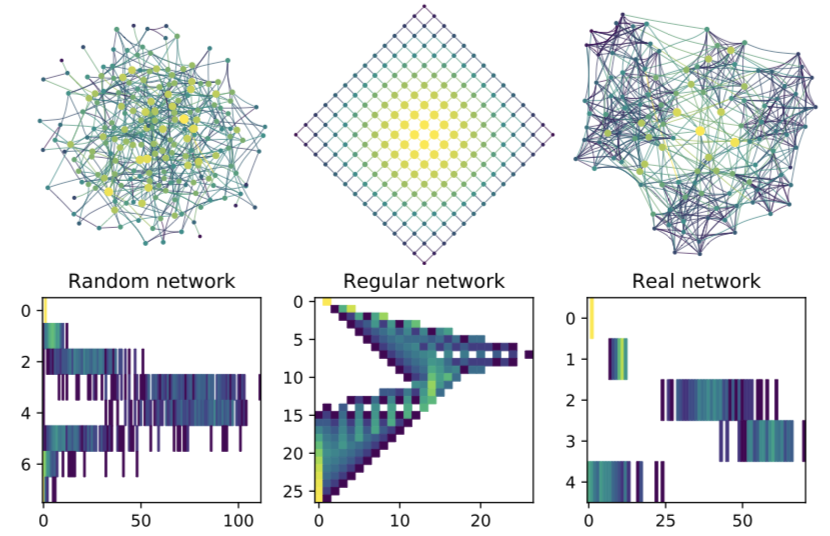Python code for computing network portrait divergences, a simple, general-purpose tool for comparing networks.
Please see the paper for more details:
An information-theoretic, all-scales approach to comparing networks
James P. Bagrow and Erik M. Bollt, Applied Network Science, 4 (1): 45 (2019)
arXiv:1804.03665
The output of each calculation is a float between 0 and 1 describing how similar the two networks are (0 = identical, 1 = maximally different, according to this measure).
Network portrait divergences can be computed at the command line or within Python scripts:
-
Basic example:
python portrait_divergence.py data/net1.edgelist data/net2.edgelist -
Networks stored in GraphML files:
python portrait_divergence.py -graphml digraph_time1.graphml digraph_time2.graphml -
Use faster C++ code (assuming it's installed):
python portrait_divergence.py --cpp big_g.edgelist big_h.edgelist -
Let's get crazy:
python portrait_divergence.py --weighted=strength -b 10 --graphml g.graphml h.graphml
The code supports directed and weighted networks.
See the help string for more: python portrait_divergence.py -h
Here's a script to compare Erdős-Rényi and Barabási-Albert graphs:
import networkx as nx
from portrait_divergence import portrait_divergence
Ger1 = nx.erdos_renyi_graph(100, 3/99)
Ger2 = nx.erdos_renyi_graph(100, 3/99)
Gba1 = nx.barabasi_albert_graph(100, 3)
Gba2 = nx.barabasi_albert_graph(100, 3)
print("Djs(ER1,ER2) =", portrait_divergence(Ger1, Ger2))
print("Djs(ER1,BA1) =", portrait_divergence(Ger1, Gba1))
print("Djs(ER1,BA2) =", portrait_divergence(Ger1, Gba2))
print("Djs(BA1,BA2) =", portrait_divergence(Gba1, Gba2))Result:
Djs(ER1,ER2) = 0.139438811433
Djs(ER1,BA1) = 0.831004770397
Djs(ER1,BA2) = 0.864124658944
Djs(BA1,BA2) = 0.214176902159
- Python 3.x with packages:
A recent install of Anaconda Python should come with everything you need.
If you use Network Portrait Divergence, please cite our paper:
James P. Bagrow and Erik M. Bollt, An information-theoretic, all-scales approach to comparing networks, Applied Network Science, 4 (1): 45 (2019) arXiv:1804.03665
Here is a bibtex entry:
@article{bagrow2019information,
Author = {Bagrow, James P. and Bollt, Erik M.},
Doi = {10.1007/s41109-019-0156-x},
Journal = {Applied Network Science},
Number = {1},
Pages = {45},
Title = {An information-theoretic, all-scales approach to comparing networks},
Doi = {10.1007/s41109-019-0156-x},
eprint = {1804.03665},
Volume = {4},
Year = {2019},
}
Portraits of Complex Networks — the original paper on Network Portraits, one of the ideas behind Network Portrait Divergence.
